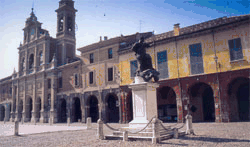Official Tourist Information Site of the Municipality of Reggio Emilia
GUASTALLA
 Guastalla is a town of Etruscan origin. It is one of the most typical towns in the lowlands of Reggio Emilia along the Po River.
Guastalla is a town of Etruscan origin. It is one of the most typical towns in the lowlands of Reggio Emilia along the Po River.
- St. Catherine's Fair (November 25th)
- Postal code: 42016
- Open-air market on Wednesdays and Saturdays
Inhabitants:
15,135 update December, 31 2009 |
How to get there:
Distance from A22 motor-way: 16 km. A1 motoway; 25 km. away. National Road SS 62, which runs from Verona to Mantua and Parma. National Road SS 63 with a branch leading to Reggio Emilia. Provincial Road to Novellara, Provincial Road to Reggiolo. Railway Station with trains to Parma and Suzzara and trains from Guastalla to Reggio Emilia. |
Tourist information:
phone 0039/522/219812 - Tourist Office; 0039/522 839711 - Municipality |
The first record we have of Guastalla dates back to 864, when St. Peter's Chapel of Guastalla was given by the emperor Ludwig to his wife Angelberga, who in turn gave the chapel to the Monastery of San Sisto in Piacenza. The abbess gave this chapel along with the Chapel of San Giorgio to Boniface of Canossa. Guastalla experienced its period of greatest importance under the Canossa family. The town hosted a convention of nobles and ecclesiastic authorities in preparation for the Council of Piacenza in 1096, and a council presided over by Pope Paschal II in 1106. Guastalla underwent various vicissitudes under rule by Cremona, Parma, and the Benedictine Monastery in Polirone, before it became the property of the Visconti family, who gave it in fief to Guido Torello in 1406. It was given to Don Ferrante Gonzaga in 1557, and remained under the rule of the Gonzaga family, who became dukes in 1621, until 1746. Guastalla was then annexed to the Duchy of Parma, but was again made into a duchy for Paolina Bonaparte during the Napoleonic Era. After 1814, Guastalla was again annexed to Parma, under the rule of Duchess Marie Louise. The town prospered due to its position along the banks of the Po River, but it also underwent the disastrous Wars of Succession. The Savoyard grenadiers had their baptism of fire in Guastalla in 1705. Guastalla is currently an important centre of communication. Located in a particularly thriving area, it is rich in industry and trade.
In its streets, its buildings and churches, and in its monuments, Guastalla still preserves the discreet charm of an old capital city. Old Via Gonzaga is the main street from which a network of checkerboard streets branches out. Via Gonzaga leads to the heart of the town, Piazza Mazzini, where the fine statue of Ferrante Gonzaga by Leone Leoni overlooks the square. The buildings facing onto the square include the 16th-century cathedral with a fašade from the late 19th century, the Duke's Palace (1567), which has unfortunately been almost completely rebuilt, and the town hall with a model illustrating the old units of measure under its portico. In nearby Corso Garibaldi stands the Maldotti Library, with more than 30,000 volumes, a collection of manuscripts and incunabula, and a rich collection of paintings. In Santa Croce Church, the Church of the Annunciation, and the Church of Servants, one can admire beautiful 18th-century altar-pieces made of polychrome scagliola work. The town theatre in Via Verdi is interesting to visit; it has recently been restored. An enchanting road leads from Guastalla to the woods on the banks of the Po River. There are two interesting monuments in the outskirts of Guastalla, an oratory dedicated to St. George, and the old Church of San Pietro in Pieve di Guastalla. Viale dei Cappuccini leads to the Oratory of San Giorgio, which is so old that it is mentioned in a deed from the 11th century. Of clear Romanesque influence, this church has a particular charm due to its small size and the expert play with architectural elements in its interior, which is composed of a small nave and two side aisles, the size of which were dictated by the desire to create a place for deep meditation. "Strada del Rosario" is the road leading to Pieve di Guastalla, where the Church of San Pietro stands. It was built around the 7th century and rebuilt in the 9th century by Deacon Everaldo. King Berengarius ordered the expansion of the church during the same century. It became the site of a synod in 1095, and of a council in 1106. In 1471, Pope Sistus IV granted the parish church the privilege of "nullius Diocesi". The most important period for the church came in 1585, when it had seven beneficed altars and jurisdiction over five rural chapels. Restoration carried out in 1605 included the covering up of several frescoes from the 15th century, marking the beginning of a series of changes that conferred the current overall appearance to the church.
Last update: 03/08/2010

SITur
Tourist Information System